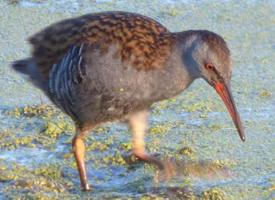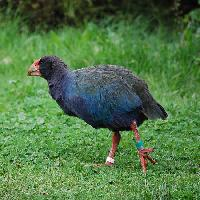
Greutăți și măsuri
| Lungime | de la 25 la 28 cm |
|---|---|
| Greutate | de la 75 la 200 g |
Descrierea animalului
The Water Rail (Rallus aquaticus) is a fascinating bird species that belongs to the rail family, Rallidae. This elusive bird is known for its secretive behavior, often hiding in dense vegetation near water bodies, making it a challenging subject for birdwatchers. Despite its shy nature, the Water Rail plays a significant role in its ecosystem and offers a captivating study for those interested in avian life.Physical Characteristics:
The Water Rail is a medium-sized bird, measuring approximately 23 to 28 centimeters in length, with a wingspan of 38 to 45 centimeters. It possesses a distinctive appearance with a slate-gray body, contrasting black-and-white stripes on its flanks, and a long, red bill with a downward curve. Its eyes are bright red, adding to its striking look. The bird's legs are long and strong, colored in a pale green, which aids in its ability to wade through marshy environments. Juvenile Water Rails have a more subdued coloration, with brown tones dominating their plumage, helping them blend into their surroundings to avoid predators.
Habitat and Distribution:
Water Rails inhabit wetland areas across Europe, North Africa, and parts of Asia. They prefer marshes, reedbeds, and dense vegetation near rivers, lakes, and ponds. During winter, northern populations migrate southwards to milder climates, including the Mediterranean region and sub-Saharan Africa. Their habitat choice reflects their need for dense cover to hide from predators and forage for food.
Diet and Foraging Behavior:
The diet of the Water Rail is varied, including invertebrates such as insects, snails, and worms, as well as small fish and amphibians. They are also known to consume plant matter, especially during the winter months when animal prey is scarce. Water Rails are skilled foragers, using their long bills to probe into mud and vegetation to locate food. They are most active during dawn and dusk, taking advantage of the low light to avoid predators while they hunt.
Breeding and Nesting:
Water Rails are monogamous birds, forming pairs that last through the breeding season. Their nests are constructed from reeds and other plant materials, usually built close to the water's edge or on floating vegetation. The female lays a clutch of 4 to 8 eggs, which are incubated by both parents for about 19 to 22 days. The chicks are precocial, meaning they are relatively mature and mobile shortly after hatching. Both parents are involved in feeding and protecting the chicks until they are ready to fend for themselves.
Conservation Status:
The Water Rail is considered to be of Least Concern by the International Union for Conservation of Nature (IUCN), thanks to its wide distribution and relatively stable population numbers. However, like many wetland species, they are vulnerable to habitat loss and degradation, especially due to drainage of wetlands, pollution, and the impacts of climate change. Conservation efforts aimed at protecting wetland habitats are crucial for ensuring the continued survival of the Water Rail and countless other species that depend on these ecosystems.
In summary, the Water Rail (Rallus aquaticus) is a secretive and intriguing bird, whose presence is a sign of healthy wetland ecosystems. Its distinctive appearance, varied diet, and complex behaviors make it a fascinating subject for study and observation, highlighting the importance of preserving its natural habitats for future generations.
Harta răspândirii

Animale similare
Fotografii noi cu animale
Top 10 animale
- Dolphin gull (Leucophaeus scoresbii)
- Diana monkey (Cercopithecus diana)
- Moustached guenon (Cercopithecus cephus)
- Galápagos tortoise (Geochelone nigra complex)
- Greek tortoise (Testudo graeca)
- Stone loach (Barbatula barbatula)
- Japanese macaque (Macaca fuscata)
- Russian tortoise (Testudo horsfieldii)
- Common flying dragon (Draco volans)
- Galápagos penguin (Spheniscus mendiculus)


